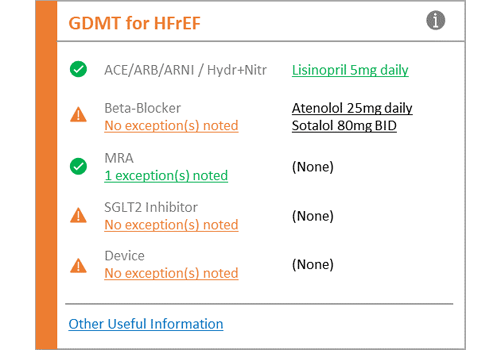Guideline-Directed Medical Therapy for Heart Failure
About

Clinical trials have shown that patients with heart failure with reduced ejection fraction (HFrEF) benefit from guideline-directed medical therapy (GDMT) management. Mechanisms to improve optimization of GDMT, such as pharmacist interventions and nurse navigator programs, may be beneficial. However, gaps in prescribing and suboptimal dosing of GDMT still exist and are attributed to an abundance of factors such as whether the patient has a history of stroke or conditions such as renal failure, as well as affordability of medications. Though there are target medications and doses defined in the guidelines for best outcomes, appropriate prescription of therapies requires a high level of personalization. The contextual information which influences decision making for GDMT prescription are not distinctly documented in the electronic health record (EHR). As such, there needs to be a way to improve documentation and tracking of GDMT and factors which influence decision making in order to accurately assess where patients are in their GDMT care trajectory.
To address this issue, HSIR has collaborated with PPG-Cardiology on multiple quality improvement projects to investigate GDMT prescription and clinician workflow at Parkview and design an application that can be integrated in the electronic health record (EHR).
Implementation of a pharmacist in the clinic and use of the EHR for prescribing medications
Our first project launched in 2018 and aimed to understand 1) the potential impact of a pharmacist in the heart failure clinic to improve GDMT adherence, and 2) gaps in documentation and patterns in workflow as they relate to medication prescription.
Retrospective chart review suggested that integration of the pharmacist in the heart failure clinic did increase adherence to GDMT within the heart failure clinic, and that GDMT prescriptions were higher in the heart failure clinic than general cardiology which did not have the pharmacist intervention. However, the data collection process revealed that intolerances and contraindications to GDMT were not documented consistently, if at all, in discrete fields. Observations in the clinic revealed that there were multiple steps and various workflows being used to retrieve the information needed for GDMT decision making at point of care. These findings informed the design of a “GDMT Snapshot” concept in the EHR that would support GDMT prescription, depicted in the image on this page. It included features such as tracking medication titration and providing supporting information in the EHR to facilitate decision making related to GDMT.
Building and testing of a GDMT tool in the EHR
In 2021, we established a multidisciplinary team within Parkview (including informatics analysts and business intelligence team members) to develop a tool in the EHR to make the GDMT snapshot concept a reality. We tested this tool with clinicians in the heart failure clinic and found that while the clinicians could see the benefit in the purpose of the tool, the tool itself required too much manual input and maintenance to be efficient and effective. We realized that we would need to build an application separate from the EHR, with the required functionality, that could be integrated into the EHR and fit seamlessly into clinicians’ workflows. We set out to begin our next project, which was designing the ideal application and determining the technical feasibility of integrating the application into the EHR.
Creating the ideal design for visualization, tracking and documenting GDMT
In 2023, we began working on the design of the application using prototyping software and usability testing with clinicians. We established a patient and family advisory council to provide input from the patient perspective. Although patients are not the end user of this application, patients are directly impacted by the GDMT decisions, so their perspectives need to be incorporated early on in the application development. The purpose of the application is to improve documentation and tracking of GDMT, as well as facilitate decision making by providing an overview of relevant GDMT-related information at point of care. The goal of this work is to reduce mortality rates and improve quality of life for those living with HFrEF.
Partners
Funding
- American College of Cardiology Accreditation Services
Publications and presentations
- Daley, C., Gregory, P., Robertson, R., Lin, HY., Pruitt, S., Cornet, V., Tan, YR., Shinde, AS., Carroll, J., Wagner, S., Toscos, T., & Mirro, M. (2023, October 11–13). Design and technical feasibility of a guideline-directed medical therapy visualization application for heart failure with reduced ejection fraction [Poster session]. American College of Cardiology Quality Summit, Orlando, FL, United States.
- Robertson, R., Flanagan, M., Howard, K., Meisberger, E., Keltner, E., Singh, L., Daley, C., Wagner, S., Toscos, T., & Mirro, M. (2022). Integrating pharmacists in HFrEF outpatient care to improve use of guideline-directed medical therapy [White paper]. Parkview Mirro Center for Research and Innovation. [link]
- Lin, HY., & Daley, C. (2022, September 20–22). Lessons learned: Development and evaluation of a GDMT tracking tool integrated within an EHR System for HFrEF using HCD methodology [Conference presentation]. HIMSS Kentucky Bluegrass Chapter Annual Conference, Florence, IN, United States.
- Robertson, R., Howard, K., Meisberger, E., Keltner, E., Flanagan, M., Wagner, S., Daley C., Toscos, T., & Mirro, M. (2020). Successful pharmacist intervention to optimize guideline directed medical therapy in heart failure patients. Journal of the American College of Cardiology, 75(11_Supplement_1), 958. [link]
- Robertson, R., Ahmed, R., Toscos, T., Cornet, V., Wagner, S., Colletta, S., Daley, C., & Mirro, M. (2020, October 8–9). Technology and workflow recommendations to improve use of guideline directed medical therapy for heart failure with reduced ejection fraction [Poster session]. American College of Cardiology Quality Summit, Virtual. [link]
Press
All projects